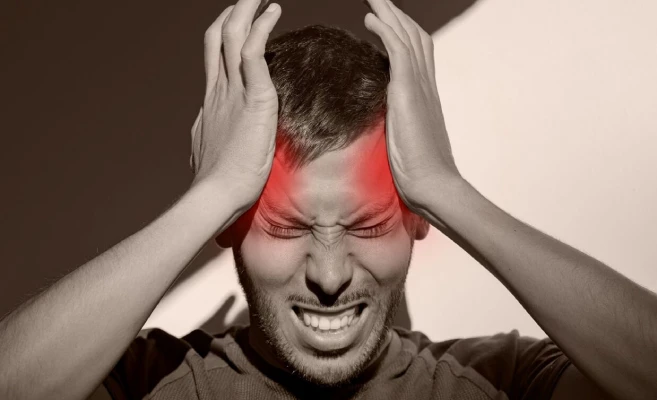Primary headaches are a common occurrence for most people. However, some secondary headaches can be a sign of a more serious medical condition. It is important to be aware of the red flags that indicate that you should seek urgent medical attention for a severe headache in the emergency room.
7 Critical Headache Symptoms Demanding Urgent Medical Attention
- Sudden, severe thunderclap headache: A sudden, severe acute headache that comes on like a thunderclap can be a sign of a subarachnoid hemorrhage, which is a life-threatening condition caused by bleeding in the space around the brain from ruptured blood vessels. It is often described as the “first or worst headache” of someone’s life, and is the most concerning of the red flag symptoms. Survival depends on rapid assessment and treatment.
- Headache with fever and stiff neck or other systemic symptoms: A headache with fever and neck stiffness can be a sign of meningitis, which is an infection of the meninges, the membranes that surround the brain and spinal cord. Associated confusion can also suggest early encephalitis. This requires rapid assessment and beginning antibiotic and antiviral intravenous treatments. New headache in an immunocompromised person whether there is fever or not also requires urgent evaluation.
- Headache with nausea and vomiting: A headache with nausea and vomiting can certainly just be a sign of a migraine headache. This typically occurs in a patterned cycle of symptoms that usually comes with migraine. However, it can also be a sign of a more serious medical condition, such as a brain tumor or stroke. If this is a new issue or a change of your normal symptoms, you should discuss the symptoms with your doctor.
- Headache that gets worse when you lie down or cough, do a Valsalva maneuver, physical activity, or any position triggered headache: A headache that gets worse when you lie down or cough can be a sign of increased intracranial pressure (intracranial hypertension), which is pressure on the brain from cerebrospinal fluid. A headache triggered by a Valsalva maneuver (bearing down such as when having a bowel movement) also needs to be evaluated. This can be caused by a variety of factors, such as a brain tumor, mass lesion, hemorrhage, or infection.
- Headache with vision changes: A headache with vision changes, such as blurred vision, double vision, or loss of vision in one eye, can be a sign of a serious medical condition, such as a stroke, brain tumor, or aneurysm (a bulge in a blood vessel). If there is papilledema (swelling of the optic nerve) on an eye exam, this requires an urgent evaluation in the emergency department.
- Headache with weakness, imbalance/vertigo, numbness or tingling in one or more limbs, or any new neurological symptoms: A headache with weakness, imbalance, dizziness, vertigo, numbness, or tingling in one or more limbs, or any new neurologic symptoms can be a sign of a stroke or other neurological disorder. Any new focal neurologic deficits with new onset of headache require urgent evaluation for secondary cause.
- Headache after a head injury: Any headache that occurs after a head injury, even if it is mild, should be evaluated by a doctor. This is because head injuries can cause a variety of serious medical complications, including bleeding in the brain and skull fractures.
Sudden Headache and Nausea
The combination of sudden headache and nausea is a particularly concerning red flag for serious headaches. It can be a sign of a number of serious medical conditions, including:
- Subarachnoid hemorrhage
- Meningitis
- Brain tumor
- Stroke
- Increased intracranial pressure
If you experience sudden headache and nausea, it is important to seek medical attention immediately.
What To Do If You Experience A Red Flag Headache?
If you experience any of the red-flag headache symptoms listed above, it is important to seek medical attention immediately to evaluate for a secondary headache disorder. Your doctor will perform a physical examination and may order further investigation with additional tests, such as blood tests, MRI, CT scan, or lumbar puncture to determine the cause of your headache.
Once the cause of your headache is diagnosed, your doctor can develop an appropriate treatment plan. Treatment may involve medication, surgery, or lifestyle changes, depending on the underlying cause of your headache.
Consult Virtual Headache Specialist: Expert Guidance for Your Headache Concerns Online
If you are struggling with a headache, you may want to consider utilizing our online platform, Virtual Headache Specialist. As an online platform, we provide comprehensive education and support for headache sufferers. It’s important to remember that our service does not replace a visit to your doctor but instead helps you understand the possible types of headache you’re experiencing based on symptoms. In addition, we hope that the information obtained can be discussed with your doctor for an improved headache management plan.
It’s crucial to be aware of the red flag headache symptoms that require immediate medical attention. Should you experience any of these symptoms, please seek medical attention promptly.
IF YOU HAVE HEADACHE, MIGRAINE, OR FACIAL PAIN AND ARE LOOKING FOR ANSWERS ON ANYTHING RELATED TO IT, A HEADACHE SPECIALIST IS HERE TO HELP, FOR FREE!
FIRST, LET’S DECIDE WHERE TO START:
IF YOU HAVE AN EXISTING HEADACHE, MIGRAINE, OR FACIAL PAIN DIAGNOSIS AND ARE LOOKING FOR THE LATEST INFORMATION, HOT TOPICS, AND TREATMENT TIPS, VISIT OUR FREE BLOG OF HOT TOPICS AND HEADACHE TIPS HERE. THIS IS WHERE I WRITE AND CONDENSE A BROAD VARIETY OF COMMON AND COMPLEX MIGRAINE AND HEADACHE RELATED TOPICS INTO THE IMPORTANT FACTS AND HIGHLIGHTS YOU NEED TO KNOW, ALONG WITH PROVIDING FIRST HAND CLINICAL EXPERIENCE FROM THE PERSPECTIVE OF A HEADACHE SPECIALIST.
IF YOU DON’T HAVE AN EXISTING HEADACHE, MIGRAINE, OR FACIAL PAIN DIAGNOSIS AND ARE LOOKING FOR POSSIBLE TYPES OF HEADACHES OR FACIAL PAINS BASED ON YOUR SYMPTOMS, USE THE FREE HEADACHE AND FACIAL PAIN SYMPTOM CHECKER TOOL DEVELOPED BY A HEADACHE SPECIALIST NEUROLOGIST HERE!


